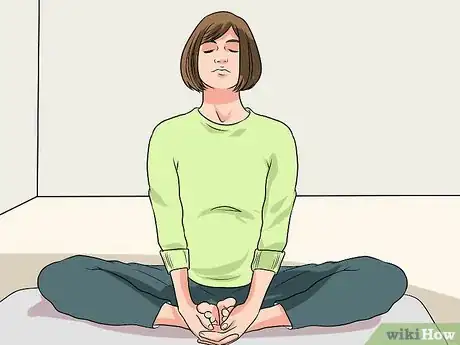This article was co-authored by wikiHow Staff. Our trained team of editors and researchers validate articles for accuracy and comprehensiveness. wikiHow's Content Management Team carefully monitors the work from our editorial staff to ensure that each article is backed by trusted research and meets our high quality standards.
This article has been viewed 60,935 times.
Learn more...
Darkness meditation is a form of meditation meant to connect you with a sense of your life and conception. The aim is to lessen the fear of darkness and the unknown. To practice, you'll first have to work on cultivating a mindset that does not fear darkness. You'll also have to make basic preparations, such as finding the right room and comfortable clothing. The routine should last about 25 minutes, and requires intense concentration. It may take you a few months to master darkness meditation.
Steps
Cultivating the Required Mindset and Environment
-
1Consider your current feelings regarding darkness. Before you begin a darkness meditation routine, you'll need to assess your current feelings. Darkness can be scary, so you'll need to know where you stand going in to see what adjustments you need to make.[1]
- People often think of death or negative emotions when they think of darkness. You may have been afraid of darkness as a child.
- Are you frightened of the dark or of being alone? If so, you'll need to work on changing your assumptions going into the meditation routine. You want to make sure you can embrace darkness in a healthy, positive way.
-
2Try to foster positive associations with the dark. With darkness meditation, the goal is to see darkness as less of a negative space and more as a quantitative and reflective one. Work on fostering some positive associations with darkness that will allow you to fully experience the meditation routine.[2]
- Many people who practice darkness meditation feel darkness contains a lot of energy. As the womb is dark, you are born from a place of darkness. Instead of thinking of darkness as blank space, think of it as a source of life.
- People often think of darkness as a base as well. In some religious traditions, darkness is thought of as what lies under all creation. Everything else is added to darkness. This can be helpful with darkness meditation as you can think of darkness as a base to which you can add reflection and insight.
Advertisement -
3Find comfortable clothing. You should also prepare on a basic level to meditate. You do not want any unnecessary distractions during a meditation session, so make sure you have comfortable clothing. Anything too tight, itchy, or otherwise uncomfortable may distract from the process of clearing your mind. Choose a loose-fitting garment you feel comfortable wearing.[3]
-
4Get comfortable in the right room. You also want to make sure you're comfortable when you're sitting down. If you choose to sit in a chair that isn't comfortable, you'll be distracted. Choose a nice, comfortable place in your home or apartment where you can meditate in peace. You can, for example, you can sit in the middle of your couch with your back straight and your feet firmly on the floor.[4]
- There is no precise pose or atmosphere required for darkness meditation. Just choose a position and location that feels right for you. The most important thing is that you're comfortable and free from outside distractions.
- You do not actually need to be in a dark room to practice darkness meditation. It's important, however, that you find a room where you can concentrate. If it's warm and uncomfortable in your bedroom, this may not be the best place to meditate. If your living room is generally a good temperature and relatively quiet, meditate here.
-
5Consider aiming for a dark room. Many types of darkness meditation focus on cultivating an internal sense of darkness. You do not necessarily need to be in a pitch dark room to practice the meditation. However, some types of darkness meditation do advocate that you aim for a room that is literally dark. In fact, people do go on darkness retreats with the goal of meditating in darkness for days. If you'd like to incorporate this type of darkness meditation, consider meditating in a dark room. The lack of light will supposedly allow you to focus more on your own thoughts and feelings given the lack of outer stimuli.[5]
-
6Clear your mind a bit before attempting to meditate. Darkness meditation requires an intense level of concentration. You may want to warm up before you begin. Try to wind down and clear your mind a bit, especially if you're under a lot of stress. Do something relaxing like reading a book or doing a jigsaw puzzle before attempting to meditate.[6]
Practicing A Meditation Routine
-
1Close your eyes and try to clear your mind. To start, you will close your eyes. You'll then want to try to clear your mind. During darkness meditation, you want to focus solely on the darkness.[7]
- Many people allow their thoughts to wander when they close their eyes. You may begin thinking of other things, such as what you have to do later today. Try to ignore these thoughts. When you begin experiencing them, return your thoughts to the darkness.
- You want to focus overcoming your fear of darkness, and everything that's represented in that fear. For example, darkness can represent the unknown and also death. Try to gain an acute sense of darkness. You'll want to focus on the darkness. What does the darkness look like? What does it feel like?
-
2Strive to see only darkness. When your eyes are closed, it's common to see images emerge on the screen of your mind. You may see colors, shapes, and may even feel like you're beginning to dream. Try to push such images away and remember to focus on the darkness only. You only want to be looking at darkness.[8]
- Keep your eyes closed tight if other images creep into your mind's eye. If this is your first time doing darkness meditation, it's very likely you'll see some images. It takes awhile to really be able to commit to seeing darkness.
- Consider the darkness you're seeing. If you begin to feel fearful, remember the positive associations with darkness. Think about being inside the womb and then emerging. Think about darkness as a blank slate. You are returning to a blank slate of non-being on which you can build yourself and your thoughts.
-
3Spend 20 minutes focusing on cultivating a sense of darkness. You should keep your eyes closed for about 20 minutes. Set a timer if necessary. During this time, you should deeply consider the darkness. Try to hyper-focus on how the darkness feels, what it means, and any insight you're gaining.[9]
- Your mind may go to scary places during the duration of this meditation. That's okay. Darkness can bring about a lot of fear. Hyper focusing on darkness for a set period of time can help alleviate some of that fear.
- Try to keep focusing on the darkness and how you feel about it. Examine any preconceived notions you have about darkness. Let bad associations give way to more positive ones. Again, think of darkness as a blank slate or in terms of your time in the womb.
-
4Open your eyes and try to bring the darkness into the room for five minutes. After 20 minutes have passed, open your eyes. Try to bring the sense of darkness into the room with you. Think about what you saw, thought, and experienced in the darkness. Try to imagine the room has that same feeling of darkness. Try to linger for about 5 minutes as you come out of your dream.[10]
Avoiding Pitfalls with Darkness Meditation
-
1Understand darkness meditation takes a lot of practice. You should not feel discouraged if your first attempt at darkness meditation does not meet your expectations. It takes a tremendous amount of practice to clear your mind and avoid going into dream mode when closing your eyes. Give it time. It may take months before you master the art of darkness meditation.[11]
- Practice darkness meditation as often as you feel comfortable. If you have a bad reaction to darkness meditation, you may want to taper off practicing until you feel more calm.
-
2Reconsider darkness meditation if you have a phobia of the dark. If you have an intense phobia of the dark, you may want to reconsider darkness meditation. While darkness meditation can help lessen fears or apprehensions regarding darkness, a phobia is a far more intense fear. Phobias should be addressed with a mental health professional and it may be dangerous to try to tackle a phobia on your own.
-
3Do not substitute darkness meditation for therapy. Meditation can help with a variety of mental health problems, but it is not therapy in and of itself. If you are experiencing an issue like depression and anxiety, do not attempt to treat it yourself with therapy. Seek out the assistance of a counselor or therapist.[12]
- You can your regular doctor for a referral to a therapist. You can also call your insurance company and ask for a list of therapists in your network.
- If you're a student, you may be entitled to free counseling through your university.
-
4Try not to stay unattached after meditating. It's important to come back to the real world after meditating. Meditation can provide a break from troublesome thoughts and allow you to take your mind off certain issues. However, you do not want to remain in a unattached state long term, as this can interfere with your ability to interact with others. Always try to return to the present moment after meditating.[13]
Warnings
- Let others in your household know that you are preparing to practice a darkness meditation, so someone doesn't accidentally open a door and disrupt you.⧼thumbs_response⧽
References
- ↑ https://articles.nithyananda.org/2012/10/meditation-techniques-to-face-your-fears/
- ↑ https://articles.nithyananda.org/2012/10/meditation-techniques-to-face-your-fears/
- ↑ http://www.the-guided-meditation-site.com/preparing-to-meditate.html
- ↑ http://www.the-guided-meditation-site.com/preparing-to-meditate.html
- ↑ http://dreamcatcherreality.com/dark-room-therapy-dmt-higher-dimensions/
- ↑ http://www.the-guided-meditation-site.com/preparing-to-meditate.html
- ↑ https://articles.nithyananda.org/2012/10/meditation-techniques-to-face-your-fears/
- ↑ https://articles.nithyananda.org/2012/10/meditation-techniques-to-face-your-fears/
- ↑ https://articles.nithyananda.org/2012/10/meditation-techniques-to-face-your-fears/
- ↑ https://articles.nithyananda.org/2012/10/meditation-techniques-to-face-your-fears/
- ↑ https://articles.nithyananda.org/2012/10/meditation-techniques-to-face-your-fears/
- ↑ https://www.psychologytoday.com/blog/mindfulness-wellbeing/201603/dangers-meditation
- ↑ https://www.psychologytoday.com/blog/mindfulness-wellbeing/201603/dangers-meditation




















-Step-18-Version-2.webp)





















































